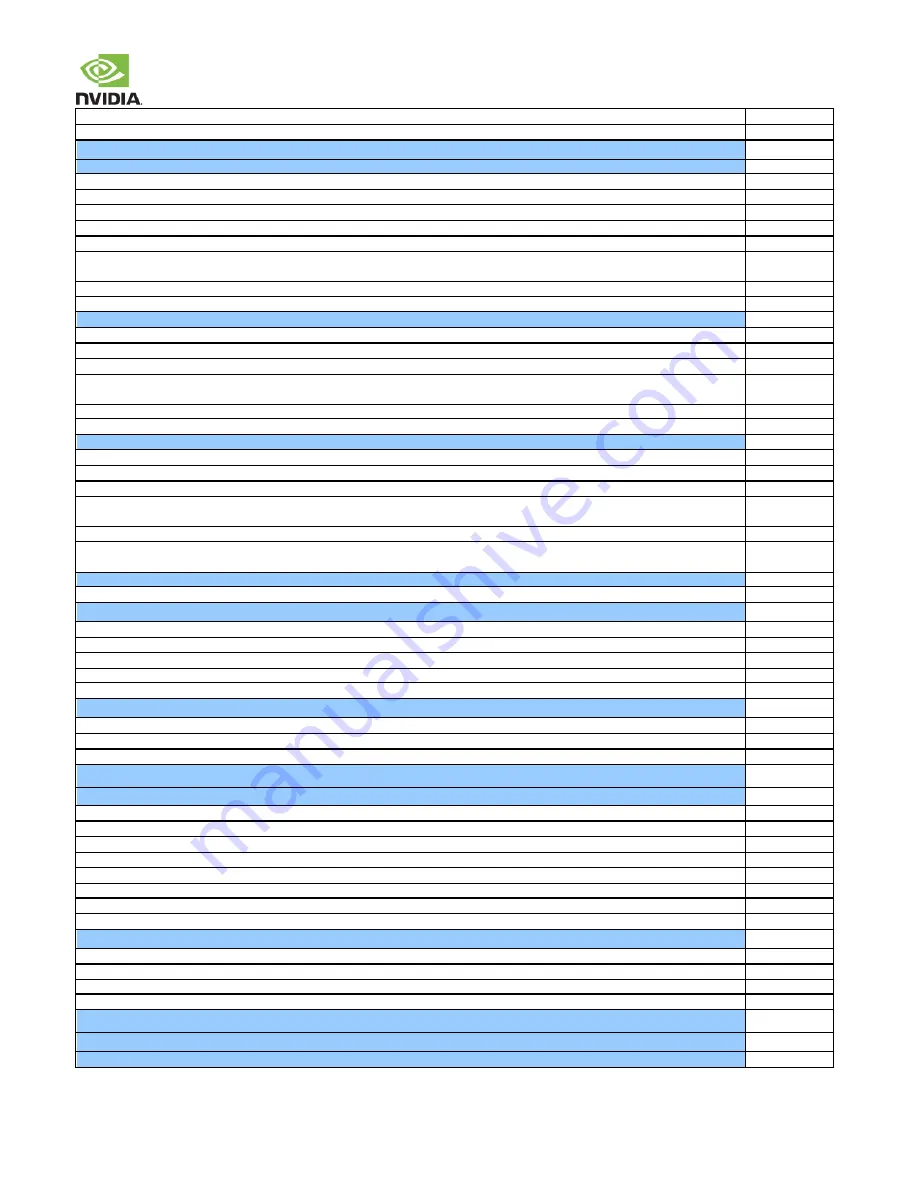
NVIDIA Jetson TX2/TX2i OEM Product Design Guide
JETSON TX2/TX2i OEM PRODUCT | DESIGN GUIDE | 20180618
82
See USB 3.0 section for Common Mode Choke requirements if this is required. TDK ACM2012D-900-2P device is recommended
See USB 3.0 section for ESD requirements. SEMTECH ESD Rclamp0524p device is recommended
PCIe
PCIe Controller #0 (x1 by default
–
supports up to x4. Lanes [2:1] of x4 configuration shared w/USB_SS#[2:1]
PEX0 used for 3.3V single-lane device/connector (lane 0 of PCIe x1 connector on reference Carrier Board)
PEX0 & USB_SS1 used for 3.3V 2-lane device/connector
PEX0, USB_SS1, PEX2 & PEX_RFU used for 3.3V 4-lane device/connector
TX+/
–
connected to corresponding pins on connector, or RX+/
–
on device on the carrier board (See Signal Terminations)
RX+/
–
connected to corresponding pins on connector, or TX+/
–
on device on the carrier board
AC caps are provided for device TX pins (those connected to the module RX+/
–
) if device is on the carrier board (See Signal
Terminations)
Reference clock used for PCIe Controller #0 (Up to x4 lane PCIe interface) is
PEX0/
–
Clock Request & Reset for PCIe Controller #0 are
PEX0_CLKREQ# & PEX0_RST#
PCIe Controller #1 (x1
–
Shared with PCIe Controller #0 lane 2)
PEX2 used for 3.3V single-lane device/connector
TX+/
–
connected to corresponding pins on connector, or RX+/
–
on device on the carrier board (See Signal Terminations)
RX+/
–
connected to corresponding pins on connector, or TX+/
–
on device on the carrier board
AC caps are provided for device TX pins (those connected to the module RX+/
–
) if device is on the carrier board (See Signal
Terminations)
Reference clock used for PCIe Controller #1 (single-lane PCIe interface) is PEX2/
–
Clock Request & Reset for PCIe Controller #1 are PEX2_CLKREQ# & PEX2_RST# (See Signal Terminations)
PCIe Controller #2 (x1)
PEX1 used for 3.3V single-lane device/connector (M.2 connector on Jetson carrier board) or USB_SS#0 (controlled by on module mux)
TX+/
–
connected to corresponding pins on connector, or RX+/
–
on device on the carrier board (See Signal Terminations)
RX+/
–
connected to corresponding pins on connector, or TX+/
–
on device on the carrier board
AC caps are provided for device TX pins (those connected to the module RX+/
–
) if device is on the carrier board (See Signal
Terminations)
Reference clock used for PCIe Controller #2 (single-lane PCIe interface) is PEX1/
–
Clock Request & Reset for PCIe Controller #1 are PEX1_CLKREQ# & PEX1_RST# (
PEX1_CLKREQ
# muxed with
SATA_DEV_SLP
on module -
See Signal Terminations)
Common
PEX_WAKE#
connected to WAKE pins on devices/connectors (See Signal Terminations)
SATA
/
–
connected to TX_P/N pins of SATA connector (or RX+/
–
pins of onboard device) (See Signal Terminations)
/
–
connected to RX_P/N pins of SATA connector (or TX+/
–
pins of onboard device) (See Signal Terminations)
See SATA section for Common Mode Choke requirements if they are required. TDK ACM2012D-900-2P device is recommended
See SATA section for ESD requirements. SEMTECH ESD Rclamp0524p device is recommended
SATA_DEV_SLP
connected to matching pin on device or connector (pin 10 on conn. shown in SATA section
–
See Signal Terminations)
Ethernet
GBE_MDI[3:0]+/
–
connected to equivalent pins on magnetics device (See Signal Terminations)
GBE_LINK_ACT, GBE_LINK100 & GBE_LINK1000
connected to LED pins on connector (See Signal Terminations)
GBE_CTVREF
–
Not used. Leave NC.
SDMMC Connections
SD Card
SDCARD_CLK
connected to CLK pin of socket/device
SDCARD_CMD
connected to CMD pin of socket/device. (See Signal Terminations)
SDCARD_D[3:0]
connected to DATA[3:0] pins of socket/device. (See Signal Terminations)
SDCARD_CD
connected to the SD Card Detect pin on socket
SDCARD_WP
connected to the SD Card Write Protect pin on socket (if supported)
SDCARD_PWR_EN
connected to SD Card VDD supply/load switch enable pin
Adequate bypass caps provided on SD Card VDD rail
Any EMI/ESD devices used are suitable for highest frequencies supported (low capacitive load: <1pf recommended).
SD Card
SDIO_CLK connected to CLK pin of device
SDIO_CMD connected to CMD pin of device. (See Signal Terminations)
SDIO_D[3:0] connected to DATA[3:0] pins of device. (See Signal Terminations)
Any EMI/ESD devices used are suitable for highest frequencies supported (low capacitive load: <1pf recommended).
Display Connections
DSI
DSI Dual Link Configurations
















































